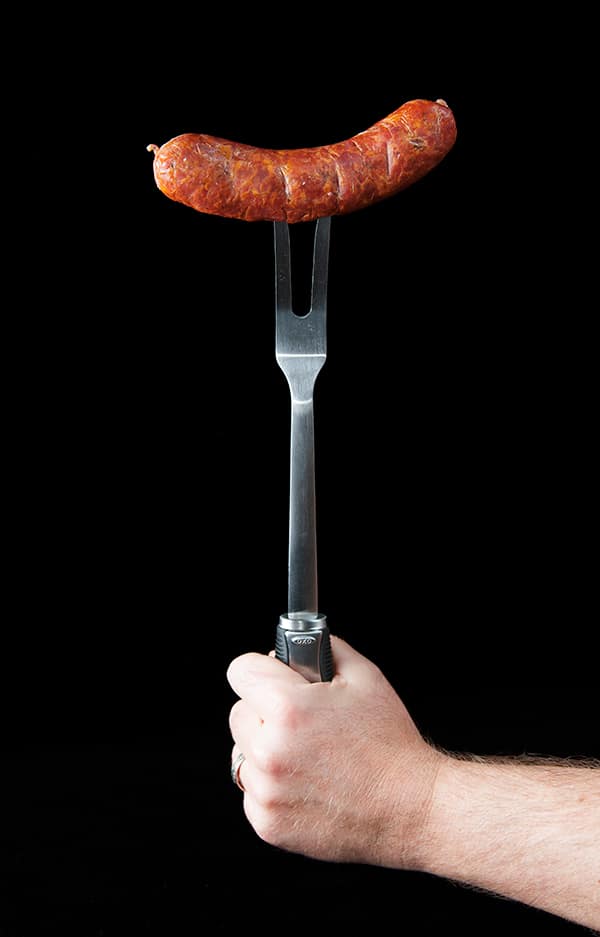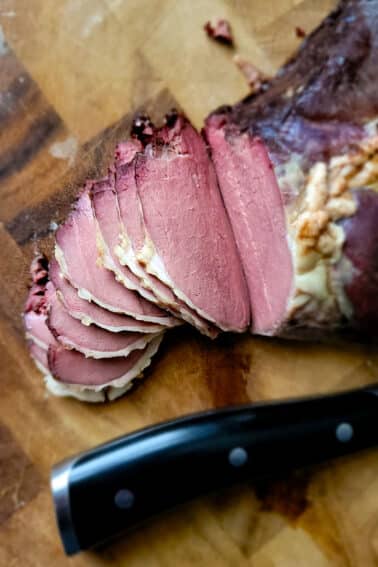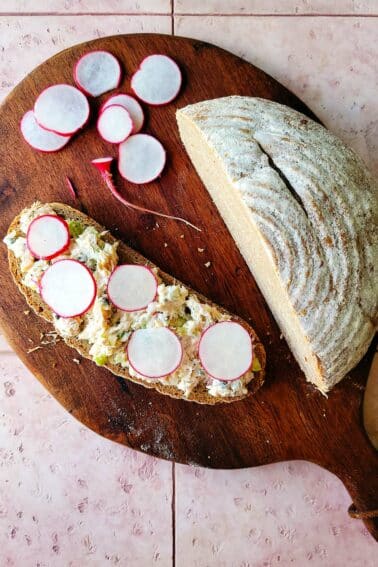As an Amazon Associate I earn from qualifying purchases.

Linguica. It’s part of the culinary fabric of California’s great Central Valley, available at every greasy spoon from Redding to Bakersfield, served at breakfast, lunch and dinner. You can thank the Azoreans for this one.
I’ve heard tell that there are more Azoreans in California than there are in the Azores, which, if you are not familiar, are a small chain of islands off the coast of Portugal. You can see their names everywhere around here: Silva, Lopes, Mendes, Machado, Costa, Cardoza. Linguica eaters, all.
What is this strange sausage of which I speak? Linguica (Ling-GWEE-zuh) is a pork sausage heavily spiced with paprika, chiles and garlic. There are all sorts of variations, but linguica is normally a coarse, country sausage, and it is often smoked. I’ve eaten linguica all over the country, but the best have been in Gloucester, Massachusetts (where my mother and sister live), and here in the Valley.
A really good linguica, to my mind, is a cudgel of a sausage. Smoky, garlicky and rich with pork fat and red peppers, it is spectacular served with grilled onions on a hoagie roll. A man’s sandwich.
The Portuguese put linguica in almost everything, but in addition to sandwiches, I love it in soups with Portuguese cabbage (which is a lot like our collard greens) and potatoes. My friend David Leite has several good recipes using linguica in his cookbook The New Portuguese Table.
I made my version with wild pig. Of course if you can’t get wild boar, you can use pork. But use good-quality pork from a good butcher or a farmer’s market. I suppose you could also use bear, too, if you have that lying around.
If you’ve never made sausage before, start by reading this detailed tutorial on how to make sausages at home.
Portuguese Linguica
Ingredients
- 3 1/2 pounds pork shoulder or wild boar meat
- 1 1/2 pounds pork fat
- 34 grams kosher salt
- 6 grams Instacure No. 1 (optional)
- 1 tablespoon dextrose or white sugar
- 10 garlic cloves, minced
- 1 tablespoon sweet paprika
- 1 teaspoon hot paprika or cayenne
- 1 teaspoon smoked paprika (optional)
- 1 tablespoon dried oregano
- 1 tablespoon crushed black pepper
- 1/2 cup dry milk (optional - it helps the sausage retain moisture while smoking)
- 3/4 cup red wine, preferably a Portuguese wine
- Hog casings
Instructions
- Chill the meat and fat until they're almost frozen by putting it in the freezer for an hour or so.
- Take out some hog casings -- you'll need about 3 to 4 standard lengths, about 15 feet -- and set in a bowl of very warm water.
- Chop meat and fat into chunks that will fit into your grinder. Combine the salt, instacure (if using), sugar, garlic, dry milk and the rest of the spices and mix it into the meat and fat with your hands. Let this rest in the fridge for about an hour. (Optional expert step: Mix the chunks of meat and fat with the salt and curing salt overnight before proceeding. Doing this will give you a better bind on the sausage.)
- Grind through your meat grinder using the coarse die, about 6.5 mm or so. If your room is warmer than 69°F, set the bowl for the ground meat into another bowl of ice to keep it cold. Put the mixture back in the freezer while you clean up.
- Add the wine to the meat mix, then mix thoroughly either using a Kitchenaid on low for 60-90 seconds or with your (very clean) hands. This is important to get the sausage to bind properly. Once it is mixed well, put it back in the fridge while you clean up again.
- Stuff the sausage into the casings. Do whole coils before making links. Twist off links by pinching the sausage down and twisting it, first in one direction, and then with the next link, the other direction. (Here's a quick video on making the links) Or you could tie them off with butcher’s string.
- Hang the sausages in a cool place. If it is warm out or if you are smoking your links, hang for one hour. If you have a place where the temperature will not go higher than 38°F, you can hang them as long as overnight.
- If you are smoking your sausages, get your smoker going while the sausages hang. Smoke the links for at least 3 hours, and as many as 12. I prefer a lighter smoke, so you can still taste the pork and spices. I prefer oak, but hickory, maple, pecan or a fruit wood would also work.
- Once the sausages have dried and/or smoked, put them the fridge until needed. If you are freezing the sausages, wait a day before doing so. This will tighten up the sausages and help them keep their shape in the deep-freeze.
Notes
Nutrition
Nutrition information is automatically calculated, so should only be used as an approximation.





Hank
Just made your linguica today. I think I have a new favorite sausage. Just awesome. I made roast pork loin on the smoker and pastrami for sandwiches for a meeting I’m hosting this weekend. I plan to serve some of these sausages sliced on the bias for an appetizer.
We used to get Silva brand when we lived in the SF Bay Area. Been living near Houston for almost 8 years and having to go without linguica of any kind. But our local Randalls just started carrying small packages of the Silva brand. Going to need to try this and see if I can make something similar in case they stop carrying it again 😉
Hello,
I have made a batch of linguica at home,nut want to refine the smoking process, what temperature to you smoke at. I hear you do not want the temperature over 165 degrees.
Adam: Not true, I smoke up to about 200 degrees all the time. My sweet spot is 160F to 200F. You won’t need too long in the smoker, either, maybe 2 hours. Check to see when they are cooked to about 155F in the center, then pull them.
My grandfather was from Faial & made the BEST Old World Linguica ever. He lived in Santa Cruz,California. I have never found anything to compare. I am now living in Fayetteville Georgia. Please advise where I can get Old World linguisa
I too am looking for a recipe like Santos made. My family bought their linguisa there for many years. It’s my favorite and I miss it. Anyone have a similar recipe? I have a recipe from Hawaii that uses cumin and cinnamon and garlic that I will try.
I just put up a batch using half moose and half pork. I also substituted a quarter cup of the wine with a quarter cup of home made red wine vinegar. This is an awesome sausage.
Rosalinda Rodrigues
Can you post your recipe. I have gotten recipes from friends’ relatives in the Azores. I have 4 Portuguese cookbooks. I made 2 1/2 batches today of the recipe above. We (in the East Bay) have been trying to find a recipe similar to Santos. I would love any help you could give us. I called in an order or linguisa, morcella, and vinha d’alhos, the day Alexander went totally nuts (evidently he was most the way there way before the murders). Of course, the orders were not filled.
I live in Massachusetts the home of linquica we have portugese. Then trees lol we have 2 company’s thamake it and ship gaspers and Michaels I prefer gaspers the best they make the three different kinds Linquica chourico and one that is made with blood
I made 10 lbs of this yesterday using 83% lean elk and 17% pork backfat. Smoked the links 4 hours on applewood then roasted it at 300 for 45 minutes or so. It is awesome. Hank said it really well when he referred to it as a cudgel of sausage. I also used all smoked Spanish paprika.
Hi everyone, I stumble upon this site and can’t help but notice the similarity of the sausage above to the Philippines version of longaniza, the recipe I use is 600 grams lean ground pork, 400 grams pork fat Hand chopped to small pieces, 1 table spoon Spanish paprika, 2 tbls cider vinegar,1 tbsp salt, 2tbls rice wine, 2 tbls soysauce. Half a cup brown sugar and a table spoon of golden syrup or maple syrup, 1 tbls of ground black pepper and 1 head finely chopped garlic, and 2tbls of Achiote oil, Mix all together and put in the casing keep refrigerated over night and boil in half a cup water till dry and fry in its own fat till caramilized but not burnt. Serve with fried rice and chilli garlic vinegar dipping sauce on the side and chopped fresh tomatoes.
I grew up in the Oakland SF bay area. My family is related to the moniz family. (( grandma was a moniz). I grew up eating that brand. Now live in the midwest. My sister
and i have searched grandmas things for the original recipe to no avail. Am eager to try this recipe.
For the first 20 or so years of my life, I had no idea just how special Santos linguica really was until later in life, when I realized that I might never find an adequate replacement. Even the fat rendered from Santos was almost as precious as the sausage itself!
Today, I went to a tiny Portuguese bakery called “Nine Islands” in Rohnert Park to buy a few linguicas and chouricos: New England Sausage Co, Fernandes and Coulart’s. Of these, Coulart’s was the best but still lacking; one common shortcoming with these and other linguicas is an inadequate usage of fat. I have not tried Netto’s yet, but until then, I will remain hopeful.
Hey Rosalinda (and you too, Mike Jones!), how about posting your recipe for us right here, right now? We won’t tell anyone!
My husband grew up eating Santos linguicia. We have a recipe that is 100 years old. My husband said our linguicia is as close to Santos as you can get. We ate planning on moving to Georgia later this year and opening up shop.
Elizabeth and Hank:
directly from the food standards and labeling handbook:
so there is no blood in chorizo and it does not have to be cured.
I am a Lopes descendant and seeing this article and my family name in it really made my day when going through and comparing recipes for a meat processing class. Hope this helps clarify any other questions.
Hi Im from Portugal, Castelo Branco
I have a recipe similar to yours that I have tried. Flavor was good, but I have one problem. It was too dry and crumbly probably due to fast smoking. I was wondering what are your recommendations and temperatures on smoking these chouricos using a modern smoker like a bradley and not old style like they do it in Portugal and that requires many days. Also the chouricos in Portugal can be eaten after smoking and do not need to be cooked, but all the information I found online says you need to cook them, which means something is missing.
thanks in advance
My grandparents came from Madeira and My father was born and lived in Lowell, Mass. I grew up on lunguisa and choeico. My father use to make a “stew” of clams, lunguica, chorico, pepperoni, potatos, onions, and kale or parsley on top. He said that it was important to put the ingredients in the pot in that order. We use to eat a lot of lupine beans, and I’ve learned to make those, too. Now that I have a meat grinder, I going to make sausages, too.
We also believe Santos linguisa is best, I would love to have the recipe, but with the factory closed down, and I imagine the family is no longer interested in making it. The factory was on Washington St. in San Leandro, Ca. My son insists if it isn’t Santos, its not really linguisa, thats how much we loved it. We used to go to get the linguisa at the factory. we are from San Leandro. We were all sad when it was closed. My last name was Lopes also.
I hear a lot of people say this recipe or that recipe is the best, but none come close to Santos.
I grew up on Santos, and it saddened me when they closed.
Not one person has ever been able to get the recipe from the family, which is a culinary catastrophe in my opinion. I can remember being the first to wake up when spending time at my grandparents for the holidays, and as any true Portuguese person knows…… If you are late for breakfast, you miss out on the good stuff.
Please if anyone can get their hands on the Santos recipe, I would be greatly in depted.
Paul
Another vote here for Netto’s! An old Portuguese grandmother in law used to cut Linguica into three inch sections and then cook them in a 200 degree oven for about three hours. It rendered out a lot of fat and turned it into something marvelous. I’m looking forward to trying this version.
azorean here. The main difference between chorico and linguica is that chorico is always cured, linguica is supposed to be raw. linguica is waaaaay more of an azorean thing than mainland portugal. i am from the south coast of mass (new bedford area) where we eat a lot of both. i was just in lisbon and they did not really know this. they thought that the linguica was cured or smoked as well and did not need to be cooked. thats how infrequently they eat it, and i was having this conversation with a native chef in lisbon. REAL linguica has to be cooked. period. so hank, you are making more of a chorico… or as the real azoreans say it : (sha-rees). we drop the o off of some words.
M. Acevedo: Good to know! Wonder if it’s different here in California’s Central Valley? This recipe is very close to a “linguica” you can buy here.